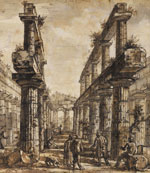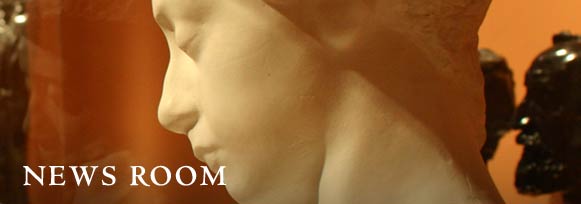Cantor Arts Center Presents Only West-Coast Viewing of Final Works by Celebrated Artist Giovanni Battista Piranesi
Piranesi’s Paestum: Master Drawings Uncovered
August 19, 2015–January 4, 2016
Stanford, Calif.—A major exhibition of Giovanni Battista Piranesi’s last master works—15 exquisitely rendered drawings made in 1777 of three ancient Greek temples in Paestum, southern Italy—opens at the Cantor Arts Center on August 19. Piranesi’s Paestum: Master Drawings Uncovered, which also includes prints and rare books of the period, sheds new light on this celebrated 18th-century artist’s working method and on the considerable impact of his oeuvre on 18th- and 19th-century architectural taste. The Cantor is the only West-Coast venue for this exhibition, which originated at Sir John Soane’s Museum, London.
While Piranesi (1720–1778) is primarily known as the creator of such famous print series as the Vedute di Roma and especially the Carceri d’Invenzione (see biographical paragraph below), this exhibition focuses on some of his rare drawings. The Paestum drawings are Piranesi’s most extensive body of work devoted to a single topographical site.
Made in preparation for his Différentes Vues…de Pesto—a book finished by his son, Francesco, and published posthumously in 1778–79—the drawings depict views of the three great Doric temples in the former Greek colony of Poseidonia, which in the third century B.C. was conquered by the Romans and renamed Paestum. (The temples were originally identified as the Basilica, the Temple of Poseidon and the Temple of Juno or Ceres, but are now determined to have been dedicated to Hera I, Hera II and Athena.) Left abandoned and cut off by a swamp, Paestum’s ruins were rediscovered in 1746 thanks to the construction of a new road. They sparked intense interest among artists and architects including Piranesi, and the consequent drawings, prints, paintings and models of the temples revolutionized people’s understanding of early Greek Classical architecture in general and the Doric style in particular. Roman architecture, until this time deemed the style that architects should emulate, now seemed derivative.
The drawings on view are also unusual within Piranesi’s portfolio due to their level of detail. Although Piranesi made preparatory drawings for most of his famous etchings, he typically drew the majority of his composition directly onto the copper plate at the engraving stage. These drawings, however, contain details very close to those of the finished prints, and it is speculated that Piranesi, aware of his failing health, included as much detail as possible so that Francesco could finish the work that his father had begun. Piranesi uses the full repertoire of his draftsmanship to create images that artistically represent the architecture of the Paestum temples and also bring out their evocative, rustic setting. Meanwhile the consecutive application of pencil, brown and grey washes, and pen and ink—sometimes with the addition of red chalk or white chalk highlights—creates a layered effect comparable to the repeated bitings used during the printing process.
Piranesi also employs the scena per angolo, a drafting method developed by 18th-century Italian stage-set designers, which replaces a drawing’s traditional, one-point perspective with several diagonal axes, thereby allowing the artist to open up the three-dimensional space for greater dramatic effect. This method was especially useful in a setting like Paestum, where many spectacular vistas were visible through the temples’ colonnades.
Well-known British architect and collector Sir John Soane, whose own oeuvre was deeply inspired by classical architecture, acquired these drawings at an auction in 1817. Since then the works have been held in the collection of a museum that Soane established in his own house after becoming a professor of architecture at the Royal Academy.
The Cantor has augmented Piranesi’s drawings with prints that include a portrait of Piranesi by the Italian artist Francesco (“Felice”) Polanzani (c. 1700–after 1783), and rare books by British and French architects who explore the importance of early Greek architecture both in Greece and in the Magna Graecia region (Southern Italy and Sicily). The books are on loan from Stanford University Libraries, Department of Special Collections; University of California, Berkeley’s Environmental Design Library; and the University of Chicago Library, Special Collections Research Center.
Wim de Wit, the Cantor’s adjunct curator of architecture and design, is delighted that the Cantor has brought this important exhibition to Stanford University and the greater Northern California community. “These drawings are unique works of art created by one of the most ingenious artists of late-18th-century Italy, and they have never been displayed anywhere outside Sir John Soane’s Museum in London until this exhibition tour,” said de Wit. “The exhibition also raises important questions about why the drawings were made and when, about the relationship between the artist’s drawings and the finished prints and about the late-18th-century revival of interest in the Doric style.”
Exhibition Organization and Support
This exhibition was organized by Sir John Soane’s Museum, London. We gratefully acknowledge support for the exhibition’s presentation at the Cantor from John A. and Cynthia Fry Gunn, Frances and Theodore Geballe's Pre-19th-Century European Art Fund, and Mary Anne Nyburg Baker and G. Leonard Baker, Jr.
Giovanni Battista Piranesi
Piranesi was born in 1720 in Mogliano Veneto, north of Venice. As a young man, Piranesi studied architecture under his uncle Matteo Lucchesi, a Venetian engineer who served as the magistrate of waterworks. He also learned etching and engraving under Giuseppe Vasi, and often visited Giovanni Battista Tiepolo, one of the great painters of his day. Around 1745, after his move to Rome, he began two projects that brought him fame: Carceri d’Invenzione, a fantastical series of 16 prints showing enormous subterranean vaults filled with labyrinthine staircases and massive machines, and Vedute di Roma, views of Rome depicting both the modern city and its ancient ruins. Later in his life he devoted himself to the measurement of many ancient Roman structures, which led to the publication of Roman Antiquities of the Time of the First Republic and the First Emperors. He also opened a printing facility, embarked on the restoration of Santa Maria del Priorato church in the Villa of the Knights of Malta in Rome, became a member of the Accademia di San Luca and was made a knight of the Golden Spur. He created his last master works, the Paestum drawings, at the end of a long illness, and died in Rome in 1778.
Cantor Arts Center
The Cantor Arts Center at Stanford University is a vital and dynamic institution with a venerable history. Founded in 1891 with the university, the historic museum was expanded and renamed in 1999 for lead donors Iris and B. Gerald Cantor. The Cantor’s encyclopedic collection spans 5,000 years, includes more than 44,000 artworks and beckons visitors to travel around the world and through time: from Africa to the Americas to Asia, from classical to contemporary. With 24 galleries presenting selections from the collection and more than 20 special exhibitions each year, the Cantor serves Stanford’s academic community, draws art lovers from the San Francisco Bay Area and beyond and attracts campus visitors from around the world. Free admission, free tours, lectures, family activities plus changing exhibitions make the Cantor one of the most well-attended university art museums in the country and a great resource for teaching and research on campus.
# # #
Visitor Information
The Cantor Arts Center is open Wednesday–Monday, 11 a.m.–5 p.m., Thursday until 8 p.m. Admission is free. The Cantor is located on the Stanford campus, off Palm Drive at Museum Way. Parking is free after 4 p.m. weekdays and all day on weekends and major holidays. Information: 650-723-4177, museum.stanford.edu, museum.stanford.edu.
Notes to Editors
• To arrange an interview, obtain an exhibition checklist, contact Anna Koster, Head of Communications, Cantor Arts Center, 650-725-4657, akoster@stanford.edu
• For high-resolution publicity images, contact PR Assistant Manager Margaret Whitehorn, Cantor Arts Center, 650-724-3600, mmwhite@stanford.edu
Learn more about programs, tours, and catalogue.

Giovanni Battista Piranesi (Italy, 1720–1778), Paestum, Italy: Temple of Neptune, View of the Interior from the West (detail), 1777. Black chalk, pencil, brown and grey washes, pen and ink. Sir John Soane’s Museum

Giovanni Battista Piranesi (Italy, 1720–1778), Paestum, Italy: Exterior of the Basilica, 1777. Black chalk, pencil, brown and grey washes, pen and ink. Sir John Soane’s Museum



